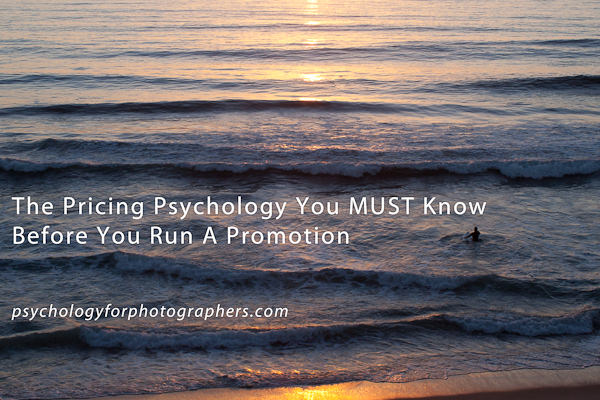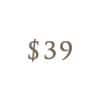The Blog Library
The Pricing Psychology You MUST Know Before You Run A Promotion

It’s almost summertime! Warm weather means more shooting, and to fill up that calendar you’ll probably be marketing and creating promotional offers.
Let me give you three small pricing tweaks that will pull in more clients without sacrificing your profit margin.
1) The truth about the number 9: It sells even better than LESS EXPENSIVE options.
You already know that $99 feels better than $100.
But did you know that $99 also feels better than $94?
Researchers looked at how well an article of women’s clothing sold at three price points: $34, $39, and $44. The clothing sold best at $39, even better than the $34 option. Nines are pretty convincing, apparently. So your promotions will probably sell the most at $499 rather than $486, for example, even if you think it’d be “nice” to kick back a few extra dollars.
In their experiment, the only thing that sold better than a price that ended in 9 was having a sale price that emphasized the original price point. For example a price tag that said:

sold better than simply displaying:

However, by far the most convincing option was:

(Thanks to Kissmetrics for bringing the study to my attention.)
So, there’s not much of an excuse for not ending your prices in 9, particularly during promotion time.
Important Note: I’m not suggesting that discounting your services is the best way to promote them; I share this research just to illustrate the power of 9. For promotional ideas that don’t involve discounting, see this post. Also, keep reading here!
2) Want people to buy your top package? Try “Useless Pricing.”
Let’s step away from photography for a moment. Say you’re looking to subscribe to a magazine. You click to the subscription page, and see the following choices – which would you pick?
1. A web-only subscription for $59
2. A print-only subscription for $125
3. A print + web subscription for $125.
Dan Ariely found that 16% chose the web-only option, and 84% chose the web + print option. Obviously, no one bought the print only option, because it’s “useless” – who would want print only when you could have both print and web for the same price?
So if the middle option is useless, then why have it at all?
Because Ariely tried taking out the “useless” option, and something interesting happened.
When he took out the “useless” option:
The $59 option went from 16% sales –> 68% sales.
The $125 option went from 84% sales –> 32% sales.
The popularity of each package flip-flopped. If you sold 100 subscriptions, taking out that middle option would have meant losing $3,432 on that promotion. Purely by deleting a single line.
So let’s say you’re doing mini sessions, and you were thinking about having a prints package and a digital files package. But instead of just having two options, why not try having three?
1) Five gift prints – $299
2) Five digital files – $599
3) Five gift prints + Five digital files – $599
(You can fill in your own prices…this is just for illustration.)
It might feel ridiculous, but field research suggests you’d see a substantial increase in people buying your top package.
“Useless pricing” works because it encourages people to focus on value rather than “discounts.”
When there are two options, people will try to talk themselves into buying the less expensive one. They will find reasons why they don’t need the more expensive one, they’ll devalue it in their minds because they’re overly-focused on price (source).
Adding a “useless option” makes the top package look like a no-brainer great value, and makes the smaller package appear far less valuable. It changes people’s focus to the content, not the price. This is great, because:
3) People prefer increased value for the same price, rather than a discount.
You know those lotion bottles at the store that say “33% more free”? That’s because it sells better than if they gave you a 33% discount on the existing bottle. Even though a 33% discount is a far better deal because it makes the price-per-unit less expensive than getting 33% “more free,” people still like the idea of getting extra value for the same price.
Tying this back to #2, having the top package be the same price (or a negligible difference) as the “useless” point makes it look like they get “more free.” This is better than if you framed it as a discount.
Take-home points about promotions:
Be sure to end a price in 9, particularly during a promotion.
When given a choice, people usually select added value over decreased price, even if decreased price would have been a better deal.
Additionally, for some promotions, consider offering a “useless” middle package to help clients focus on value instead of price. You’ll likely see a dramatic increase in selling the top package.
Speaking of promotions, 😉
If you liked this post you might check out my popular e-course Irresistible Words. You know how to price a promotion now – but do you know how to write one?
Irresistible Words walks you through the process of persuasion so you can repeat it yourself, teaches you to write blog posts flash-fast, and puts an end to the head-banging of “I don’t know what to say.”

Check it out here.

Jenika, this article is GREAT! I personally like to have one up on how the marketing ways of the world try to guide my decisions. In addition to the fantastic article, I am going out to buy a new wardrobe, and I will tell my wife I add so much more value to the family when I am dressed to the 9’s…….. 🙂 LOL
Craig
It’s very strange to hear that people figure out what to purchase in this way. I figure things out very logically when determining the best deal. It makes it hard for me to price for the people who think the way you have laid out.
If you thought this was crazy, stay tuned….the way most people think about pricing is actually incredibly illogical, context-dependent, and often backwards. And it’s worth knowing about! 🙂
That was a very smooth transistion to marketing your product. I like it! Your idea about ending your pricing in the 9s is pretty slick.
After reading this post, I changed my standard pricing with a strick through initial price then followed by a price with a 9 on it.
I’ll let you know what happens through out the year. I wish I can afford our one on one consult.
I meant ‘your’ one on one 🙂
Just sent some friends on over to your blog cause you’re such a smarty and we can all learn from the great insights you provide. Love this post!
Wow – the human mind is quite interesting. Thanks for all the articles – they are helping me a lot as I transition into a higher echelon of clients.
Great article. I have a question about the “9s”. What if you have a price of $1599, and you show -$-1-5-9-9- (those hash lines are supposed to be a strike through line) marked down to $1199. Is this as effective if the original price was $1600 instead?
Interesting question, Chris. I don’t think I have any data to give an answer, but just writing both options down on a piece of paper here at my desk, my instinct is that the 1600 looks more convincing (since in four digit numbers, the first two make the most difference). That’s my take anyway. Above all, I think you having the crossed out price next to the new price is a smart strategy.
Great summary and instruction.
I teach the same pricing strategy for my photography clients as well where irrational consumer behavior rarely changes and in situations where pricing exceeds $99, people automatically switch to a more analytical and risk-averse mode in their decisions – which often results to them being even more price conscious.
The most common response of photographers when their buyers reach this stage of thinking is to feature dump, which makes the matter worse as it puts the buyers into a more analytical mode rather than buying off emotional value, which is really what photographers are selling.
The way you explained how it flips their mindset from discount hunters to value seekers is excellent. I never thought of wording it that way. That’s just awesome.
All the best Jenika
David Lee Tong
Hi Jenika. I know that this post is old (sorry) but I have a few questions.
I have heard that often, those who are not price shoppers, but value shoppers actually prefer the higher prices because it makes them feel like they got a higher quality product ($150 bottle of wine vs $15 wine. People prefer the $150 bottle even if it is the same). Do you think that this could actually hurt photography pricing if I had a $1999 package vs a $2000 package? It would seem that that would actually encourage the price shoppers and maybe even discourage the value shoppers.
Good question. I think if someone’s looking for a higher priced and higher quality product, they’d be looking at a $2000 photographer instead of a $200 photographer, not a $2000 vs. $1999 photographer. (I’d also point to the car market, where even nice cars are marketed as “starting at $49,999.”)
If you check out a post I did on the psychology of small purchases, you’ll see more info about pricing in big vs. small chunks.
After I read your post, I starting re-working my pricing page to include the rule of 9s
After changing the prices, most taken up to 9 (verses subtracting to 9), my mind started to tell me that my prices were way too low!
Even though I was in on the secret, and I actually increased my prices, because they ended in 9 I was tricked into subconsciously thinking they were too low!
wow.
unreal!
This is a fantastic post. Megan has encouraged me to change my pricing so I’m soaking up all the strategies I can. I will do the 9s and the cross through AND the useless package. Would having 4 options throw off the balance of using the “useless” system?
I think it’s so interesting! I live in Mexico, here I’ve found a very difficult situation, people think there are some things and services that are not worth spending on, photography is one of them… as graphic design, marketing even sometimes…
I’m friends with some photographers and the problem they are always complaining is : “there are too many people out there selling themselves as -professional photographer- charging the ridiculous price of 40 dollars, giving unlimited digital frames, almost every frame on printed version and people asks us -why are you charging me that much? Juanito can make it for 40 and gives me all this stuff-” It’s a never-ending subject among the photographers here… do you have any suggestions to fight effectively this situation?